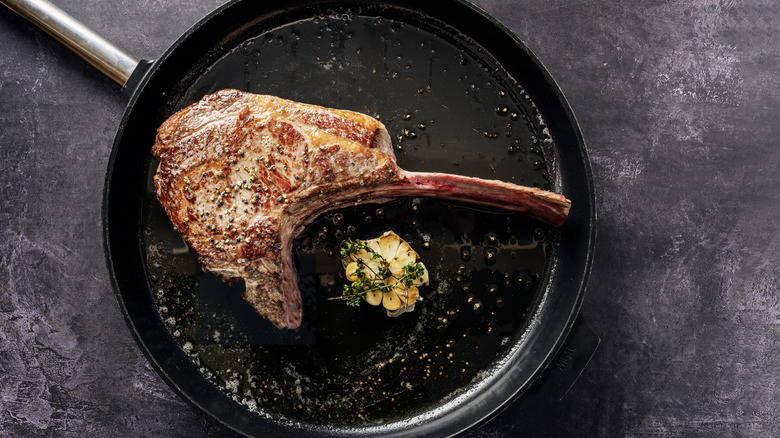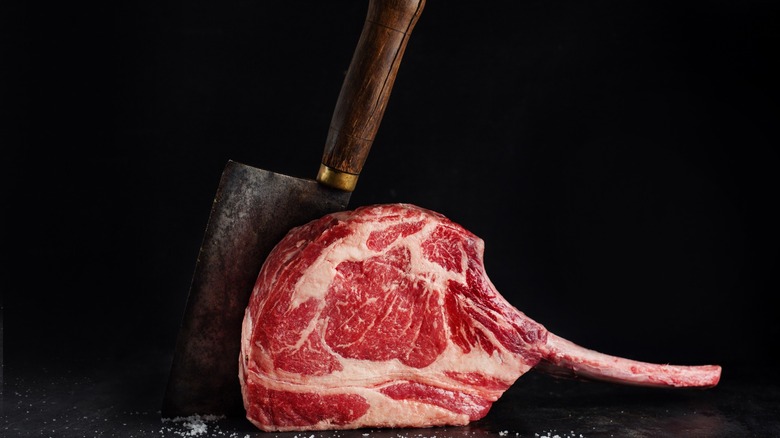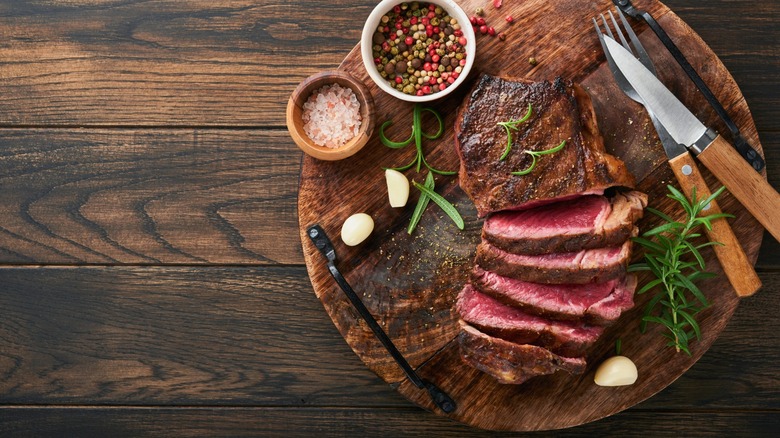Bone-In Steak Isn't Actually More Flavorful Than Boneless
Meat lovers will often espouse the wonders of grilling a steak with the bone still inside due to the way it can enhance the flavor, but this isn't entirely true. The thinking behind this theory is that the tasty, fatty flavors of the bone marrow will seep through into the rest of the steak, but there's no scientific basis to back this up. The truth is that the wall of bone, as well as the layers of sinew and muscles surrounding the bone, are much too thick to allow the passing of any sort of flavoring from inside or just outside the marrow to soak through the rest of the steak.
To be fair, this perspective is rooted in some valid points. Bone marrow is a delicacy for its rich, creamy flavor and was known as "prairie butter" to cowboys in the American Old West, but the only way to reach it is to physically crack open the hard bone that traps the material inside. The fat and collagen surrounding the bone are also tasty, which is why some find it so satisfying to suck on the leftovers of a T-bone steak after all the meat is gone. However, as delicious as that sounds, none of this is soluble enough to melt inside the meat.
Insulating a steak with a bone
Since the contracting of muscle fibers during cooking pushes the moisture out of a steak, fat and juice traveling deeper inside a piece of meat when exposed to heat would break the laws of chemistry and physics. However, this doesn't necessarily mean that aren't any benefits at all to cooking bone-in steak. On the contrary, the bone will affect the entire cooking process, determining the taste and texture of the final outcome since the bone acts as an insulator.
This means that the bone acts as a barrier to heat, lengthening the time it takes for the meat directly surrounding this section of the steak to reach the same temperature as the rest of it. As a result, meat closer to the bone will be rarer and more tender. Although none of the actual flavors of the bone or surrounding tissue will make their way to the rest of the steak, the juices that seep out will inevitably be quite delectable. As Steven L. Moore, Director of Innovation at the food science consultancy firm Brand Formula, explains, "Bone... seals the muscle from losing meat juices as it is cooked. So when a muscle is de-boned there is usually a large area now that is exposed muscle, no longer sealed to help maintain juices through cooking," per Amazing Ribs.
Bone or no bone?
The bone-in vs. boneless debate all comes down to personal preference. Remember that although the actual bone doesn't provide additional flavor, the tender and juicier pieces of meat that result from a lower and slower cooking process are probably the reason behind this myth in the first place. On one hand, bones provide a different, arguably higher quality of meat cooked at a lower temperature, about five to ten degrees cooler, than the rest. At the very least, it allows for more variety when carving up a steak. If someone prefers their steak medium-well, for instance, the portion closest to the bone might satisfy someone who wants their meat cooked slightly less. In addition, bones are just nice to suck on. Those fatty, sinewy fibers are still packed with flavor on their own, after all.
On the other hand, the bone section might be a little too raw and chewy if the rest of the steak is cooked to rare or medium-rare doneness. Searing boneless steak will also result in a crispier and more even outer crust. If you couldn't care less about the bone, it may be more financially prudent to go with a boneless cut, too, as the weight of the bone will usually raise the cost of the steak. Whether you're pro-bone or prefer a bone-free steak, it's all up to you.



